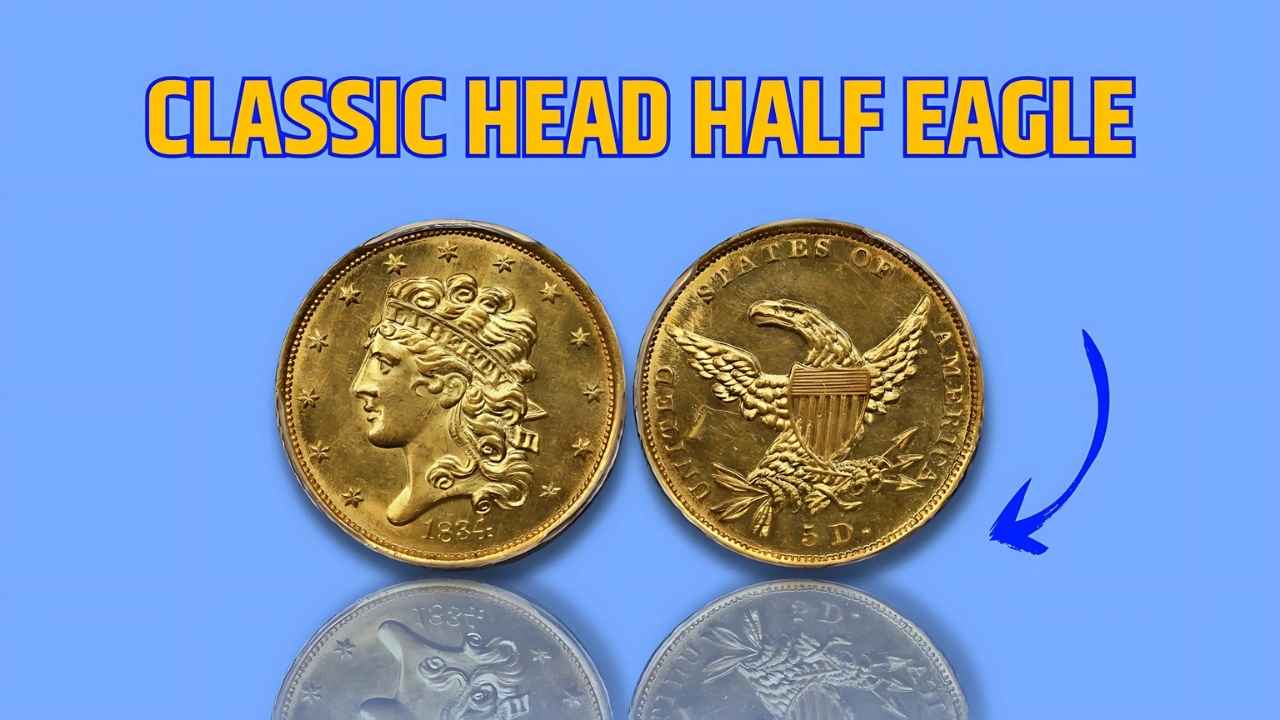Classic Head Half Eagle: In the early days of the United States Mint, gold coins weren’t just currency — they were a symbol of national growth, economic change, and historical legacy. One of the most iconic examples of this is the Classic Head Half Eagle, minted from 1834 to 1838.
Though once worth only five dollars, today these coins — when preserved in excellent condition — can fetch as much as $90,000. But what makes this specific gold piece so valuable and important?
Let’s take a closer look at the story behind the Classic Head Half Eagle.
Background: Why the Design Was Introduced
Before 1834, U.S. gold coins had a problem: their gold content was too high, and as a result, they were often melted down for profit or hoarded. This made it difficult for gold coins to circulate in everyday use. In response, the Mint adjusted the gold standard with the Coinage Act of 1834, reducing the gold content slightly to bring the coin’s face value closer to its actual worth.
This change not only helped gold coins stay in circulation but also led to the introduction of a new design — the Classic Head, crafted by Chief Engraver William Kneass.
Key Features of the Classic Head Half Eagle
The Classic Head Half Eagle carries several features that distinguish it from earlier and later gold coins:
- Obverse (Front): Lady Liberty facing left, with thick curls and a headband reading “LIBERTY.” She is surrounded by 13 stars representing the original colonies.
- Reverse (Back): A simple heraldic eagle without the motto “In God We Trust,” holding arrows and an olive branch.
- Gold Content: Approximately 0.24187 troy ounces.
- Denomination: $5 (but often referred to as a “Half Eagle”)
Produced in Philadelphia during its five-year run, the coin came in several variations, especially in terms of date spacing and edge design — making some editions rarer than others.
Why It Can Be Worth $90,000 Today
While millions of coins were produced during this era, most did not survive the test of time in pristine condition. The rarity of the Classic Head Half Eagle, especially in uncirculated or mint state, is what gives it such high value today.
- Mint Condition examples — with no wear and excellent luster — are extremely scarce.
- Coins with historical anomalies, die varieties, or limited mintage years like 1834 Crosslet 4 are especially desirable.
- Some specimens have been graded MS63 or higher by services like PCGS or NGC, which significantly increases their market price.
In 2023, one particularly rare version of the 1836 coin sold for $90,000 at a private auction — making it one of the most sought-after Classic Head Half Eagles in the collector’s world.
Collectibility and Legacy
The Classic Head design was short-lived, but it played a crucial role in the evolution of American coinage. Collectors appreciate it not only for its artistic beauty and gold content but also for the historical transition it represents — a time when America was trying to create a more functional and reliable currency system.
Today, these coins are not often seen outside of numismatic shows, private collections, and auctions. For collectors, finding a well-preserved Classic Head Half Eagle is like uncovering a piece of early American economic history.
How to Spot a Valuable One
If you happen to own or come across a Classic Head Half Eagle, consider the following:
- Condition is everything: Coins with wear may still be valuable, but not nearly as much as mint-grade versions.
- Year and variety matter: Coins from certain years, especially those with design errors or low mintage, are more valuable.
- Authentication is crucial: Professional grading by trusted companies adds credibility and can raise the value dramatically.
The Classic Head Half Eagle from 1834 to 1838 isn’t just a collectible — it’s a story captured in gold. Once worth just five dollars, its current value of up to $90,000 reflects not just the rarity of the coin but the rich history behind it.
Whether you’re a seasoned numismatist or a history enthusiast, this coin offers a tangible connection to the early financial fabric of America — a legacy preserved in gold for nearly two centuries.




